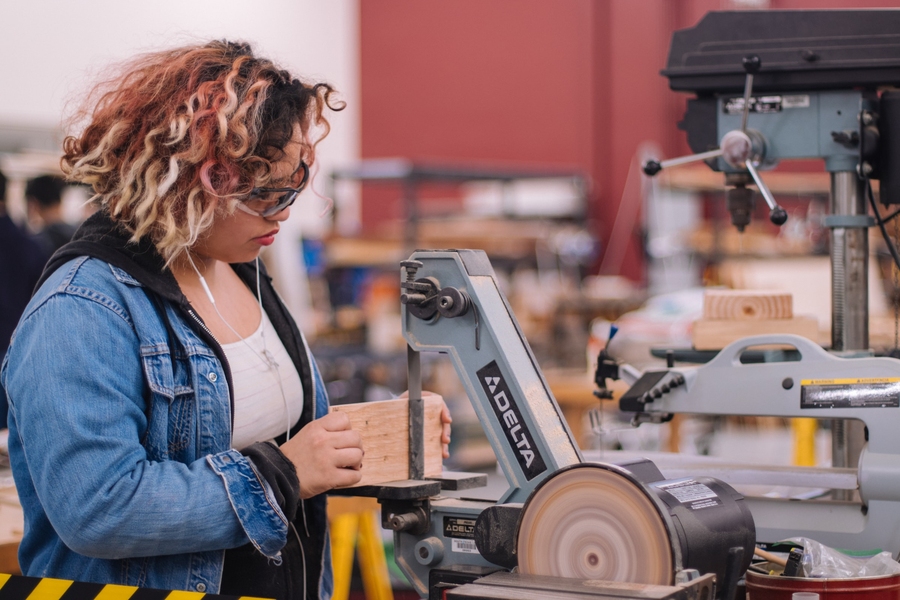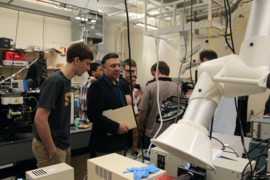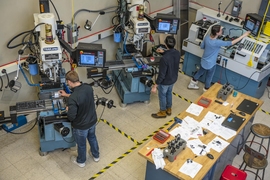The pandemic underscored an urgent need: The best-educated workers are prospering, but too many others are being left behind. To address this challenge, community colleges can be rich resources for educating the higher-skilled workers that industry is now demanding. However, schools, working with employers and policymakers, must do more to bridge the gap between education and employment.
This July, in a statewide effort to build new education models for advanced skills, MIT Open Learning and MassBridge hosted “Bridging the Education/Workforce Gap: Community College and Beyond,” a two-day conference with thought leaders from all parts of the education-workforce equation to explore how to expand and create new training opportunities that prepare students for quality jobs. Building on new models discussed in a recent MIT study (MassBridge Advanced Manufacturing Education Benchmark Report), speakers shared further ideas on how to bridge that gap between education and employment across many different sectors.
Throughout the conference, some common themes emerged:
- The workforce needs agile learners who can upskill easily.
- Industry needs change rapidly, so training programs need to adapt accordingly.
- Partnerships with employers in the industry are key.
- Courses, apprenticeships, and credentialing need to be accessible to all learners.
Day 1: Education perspectives
On the first day of programming, professionals from community colleges, state government, and industry recognized the growing need for adaptable workforce training programs at both the entry level and the incumbent worker level, which will require strong partnerships between educational programs and employers. George Westerman, senior lecturer at the MIT Sloan School of Management and a principal research scientist at J-WEL Workforce Learning, says “We need a new model for employers to help create the workers they need, rather than trying to find them.” A flexible hybrid online/in-person model would allow a wider range of students to access and complete these programs. Training programs should emphasize “human skills” that workers will still be able to leverage even as hard skills evolve.
In “The Changing Face of Community College Education,” panelists who work at community colleges discussed the growing demand for incumbent worker training and fast-tracked entry-level workforce training. Repackaging curricula with tangible milestones such as “stackable credentials” would accelerate the path to a degree for part-time students, they said. Focusing on “credentials of value” can embed employer needs from local industry in courses.
Moderated by Bob LePage, Massachusetts assistant secretary for career education, a panel on the role of education policy focused on the opportunities to rebuild and modernize the education system. The pandemic has shown that a hybrid education approach could be an equitable strategy that combines the best of digital access and hands-on activities to accelerate student learning. Beyond the classroom, schools need scalable work-based learning opportunities beyond registered apprentices. Federal and state policymakers are also looking to embed industry partnerships into the traditional degree model, speakers said.
In “A Cross-industry Look at Education Needs,” panelists from Mass Tech College and University, Beth Israel Deaconess Medical Center, the University of Massachusetts, and the University of Pittsburgh Medical Center discussed the challenges of finding qualified candidates for technical jobs. They envisioned a system for incentivizing these difficult-to-fill positions by partnering with community colleges to offer short-term training for lower-wage workers. By training the existing workforce, employers can better evolve to fit their own needs.
A keynote presentation from Bill Bonvillian, senior director of special projects at MIT Open Learning and lecturer at MIT, and Sanjay Sarma, vice president for open learning, focused on the high labor nonparticipation rates that have been building over the last 15 years and exacerbated by the pandemic. Recent reports show millions of higher-skilled jobs are going unfilled because we lack the workforce education system to train those who can fill them. The labor market information chain is broken: Workers don’t know what skills they need, educators don’t know what skills to educate for, and employers don’t know what skills workers have. “The social contract of universities has to change,” Sarma said. “Ideally, such a contract would provide “a holistic education to people who need it in the workforce.”
Drawing from Bonvillian and Sarma's recent book "Workforce Education," Bonvillian offered recommendations for new delivery models of training, such as breaking down the work/learning barrier with more apprenticeships; creating “trifecta” programs at community colleges that reach high school students, community college students, and incumbent workers; implementing short courses that lead to certificates and degrees for students who are already in the workforce and have time restraints; and integrating federal programs at the state level. Bonvillian said, “Designing programs that complement each other ... blurring the line between degrees and credentials, filling gaps where Pell grants don't help on workforce needs — these are all programs that have come right out of those combined education-industry efforts.”
Day 2: Industry, government, and student perspectives
Workers of the future will need to be trained in digital literacy, hands-on abilities, and critical thinking. Speakers on the second day of programming indicated a strong drive, persistence, and curiosity from community college students that can be fostered through targeted training programs.
In the panel “Up and Coming,” MIT mechanical engineering lecturer John Liu moderated a conversation with a group of current and former community college students who returned to school after a stint in the workforce to pursue training in another field. Their motivations ranged from pursuing their passions to helping others to creating a more stable future for themselves. One panelist, Mussie Demisse, was a former Bunker Hill Community College student who went on to graduate with a bachelor’s degree from MIT. Demisse said the MassHire program, which supports student success through state funding and industry involvement via individual coaching and internships, “aligned their goals with mine for my betterment, and that made it easier for me to align my goals with them.”
Keynote speaker Celeste Carter, lead program director for advanced technological education at the National Science Foundation (NSF), shared how the NSF developed a program that looked at innovative strategies to educate the skilled technical workforce. Carter said communication with students is hugely important to training programs. “There’s a lot of curiosity, a lot of persistence, a lot of really smart people at two-year institutions. We need to take advantage of it,” she said.
In a panel on statewide agency and collaboration, statewide education leaders who work for different institutions in different states shared how they have seen similar successes through partnerships, listening, and flexibility. Panelists said it’s important to have a flexible program structure that can adapt to these evolving needs of employers and students. Amy Firestone of Apprentice Carolina and South Carolina’s Technical College System shared how their “3D process” (which stands for “discovery, design, and delivery”) informed their program.
Crossing organizational boundaries
Across two days of panel discussions, educators, policymakers, industry leaders, and students spoke to the success of partnerships between educational institutions and employers. If employers have a vested interest in the outcomes of training programs, students will be trained with the current needs of their industries in mind, and will be better prepared for the workforce upon graduation, they said.
"One word we heard a lot during this conference is “partnership,” and that’s so important,” says Westerman. “Because we have a gap, and you can't cross this gap on your own. We all know that crossing organizational boundaries is an unnatural act, and so we all have to find ways to get across there."










